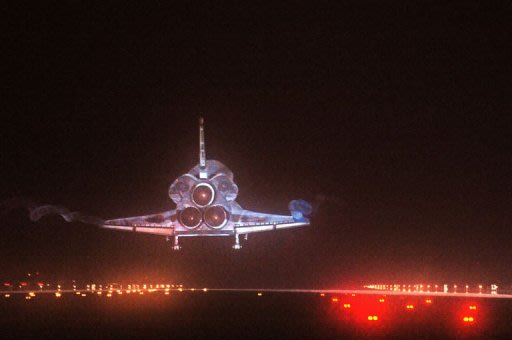Space Shuttle "Atlantis" Tribute

"It's been an unbelievable and amazing journey."

Shuttle Atlantis touches down at NASA's Kennedy Space Center Shuttle Landing Facility in Cape Canaveral, Fla., completing its 13-day mission to the International Space Station and the final flight of the Space Shuttle Program, early Thursday morning, July 21, 2011. Atlantis, the fourth orbiter built, launched on its first mission on Oct. 3, 1985.
"Mission complete, Houston,"
shuttle commander Chris Ferguson said as the black and white orbiter, emblazoned with an American flag, rolled to a stop."The space shuttle has changed the way we view the world. It has changed the way we view our universe," he said. "There was a lot of emotion today but one thing is indisputable: America is not going to stop exploring
On the 13-day mission, the STS-135 crew delivered to the International Space Station more than 9,400 pounds of spare parts, spare equipment and other supplies in the Raffaello multi-purpose logistics module, including 2,677 pounds of food. The supplies will sustain space station operations for the next year. The 21-foot long, 15-foot diameter Raffaello brought back nearly 5,700 pounds of unneeded materials from the station.
Columbia exploded in 2003 and Challenger was destroyed in 1986 in accidents that killed a total of 14 crew members.
Those disasters left only three in the space-flying fleet, along with Enterprise, a prototype that never flew in space. The quartet will become museum pieces in the coming months.
Marc Garneau, who became the first Canadian to go into space when he was launched aboard the shuttle Challenger in October 1984, says the return of Atlantis marked the end of an era "where we did incredible things."
But the astronaut-turned-politician says the all-purpose space vehicle was still too dangerous even if it made 135 flights.
"Two tragedies out of 135 flights is too many," he said in a recent interview with The Canadian Press.
During 30 years of shuttle flights, 14 astronauts died in two accidents. Challenger erupted into a fireball during its launch on Jan. 28, 1986, and Columbia broke apart on Feb. 1, 2003, as it returned to Earth.
With the shuttles' retirement, a Russian Soyuz space capsule will carry Hadfield to the orbiting space lab in late 2012.
Space shuttle Atlantis is revealed on Launch Pad 39A at NASA's Kennedy Space Center in Florida following the move of the rotating service structure (RSS).
We Have Liftoff!
Space shuttle Atlantis launches into history at 11:29 a.m. EDT from Launch Pad 39A at NASA's Kennedy Space Center in Florida.
Atlantis Soars Into Space
Space shuttle Atlantis is seen through the window of a Shuttle Training Aircraft (STA)


A 3D model of the space shuttle ascends in Google Earth.
Space Shuttle Program Announces Commemorative Patch Contest Winner

Mr. Blake Dumesnil, Hamilton Sundstrand, Johnson Space Center
Second Place:
Ms. Jennifer Franzo, Michoud Assembly Facility, New Orleans

 Third Place:
Third Place:Mr. Tim Gagnon, Kennedy Space Center, Florida






No comments:
Post a Comment